Madagascar is an African country made up of one large island and many tiny nearby islands. It lies in the Indian Ocean, about 240 miles (386 kilometers) southeast of the African mainland. The large island, also called Madagascar, is the fourth largest island in the world. Only Greenland, New Guinea, and Borneo are larger islands. Most of the country’s people are farmers or herders of mixed African and Indonesian descent. Antananarivo is the capital and largest city.
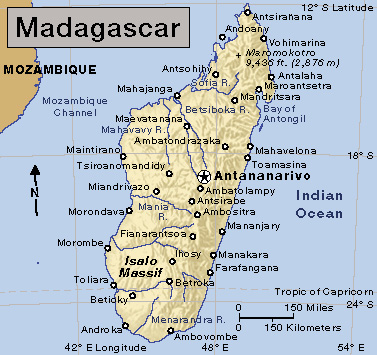
Madagascar was a favorite base for sea pirates in the 1600’s and 1700’s, including the famous Captain William Kidd. Later, it became a haven for enslavers. In the early 1800’s, most of Madagascar became part of the local Merina kingdom. The Merina kingdom fell to the French in 1896, and all of Madagascar became a French colony. Madagascar gained independence from France in 1960. It was called the Malagasy Republic until 1975, when its name was changed to Madagascar. Its official name is the Republic of Madagascar.
Government.
The head of state is the president, who is elected by the people to a term of five years. The president appoints a prime minister and, on the recommendation of the prime minister, the other members of the Council of Ministers. The members of the National Assembly, the lower house of the nation’s legislature, are elected by the people. Two-thirds of the members of the upper house, the Senate, are chosen by local officials. The president appoints the other one-third.
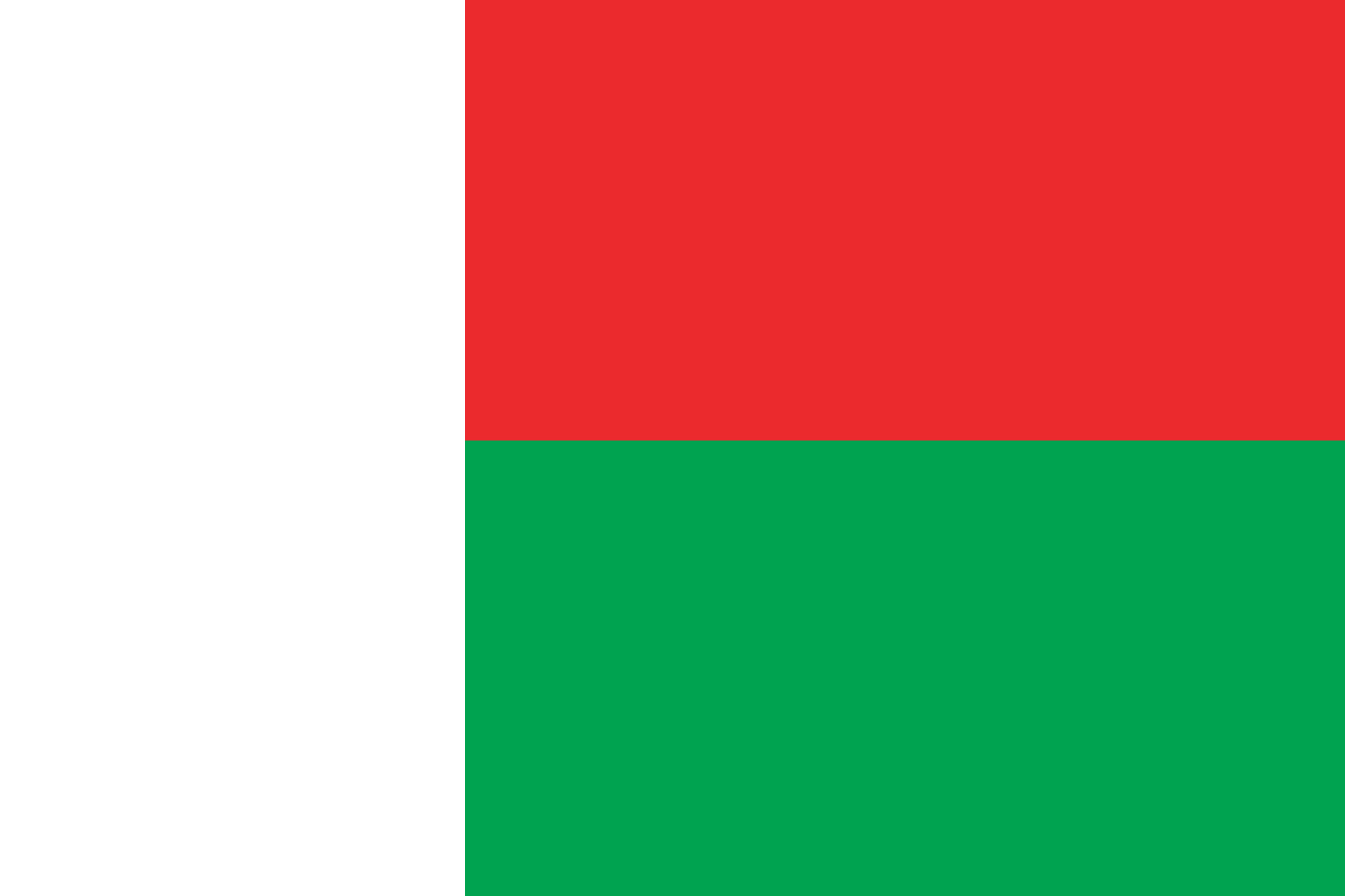
People.
The people of Madagascar are called the Malagasy. The country’s population is made up of several ethnic groups of mixed Indonesian and African descent. The ethnic groups of the central and south-central highlands tend to resemble Indonesians. Many raise rice in irrigated fields just as do farmers in Indonesia. The coastal ethnic groups more closely resemble continental Africans. Many herd cattle as do peoples of eastern Africa. Political rivalries exist between the coastal and the highland peoples of the country. But coastal and highland people share control of the government of Madagascar.
Loading the player...
Madagascar's national anthem
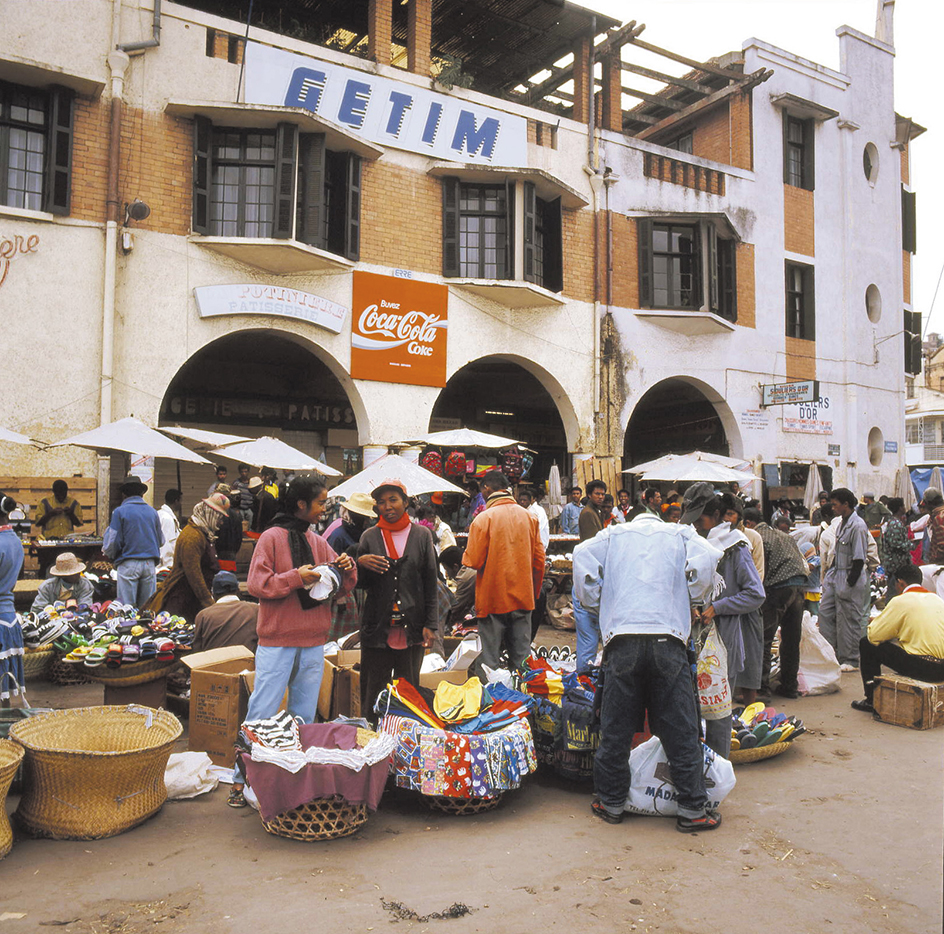
Malagasy is the language spoken throughout the country. It resembles Malay and Indonesian. Malagasy, French, and English are the official languages. About two-fifths of the people are Christians, and nearly one-tenth are Muslims. The rest—especially those living along the coasts—practice local African religions. They worship ancestors and spirits.
The people of Madagascar have great respect for their ancestors. They devote much time and effort to caring for their graveyards. Many tombs look like painted houses. Other tombs have beautifully carved wooden ornaments called staffs on top. The Malagasy who practice local African religions perform cattle sacrifices and other ceremonies at family tombs.
Many people of Madagascar wear European-style clothing. The country’s markets sell many American T-shirts and blue jeans. But each region in Madagascar has a distinctive straw hat that the people wear on special occasions. The people who live in isolated southern regions often wear little clothing. Most houses in the country are built of brick, and many are several stories high. They have tile or thatched roofs. The people eat rice, vegetables, fruit, and sometimes meat and fish.
Most of Madagascar’s adults can read and write. Almost all the children attend primary schools, but only about a fifth of the children attend high school. The University of Antananarivo is the country’s main university.
Land and climate.
Northern Madagascar has fertile soil. Mountains separate it from the rest of the island. Western Madagascar has wide plains, some fertile river valleys, and a fairly sheltered coast. A narrow plain lies along the east coast, but reefs and storms make the east coast dangerous for ships. Some coastal shipping uses the Ampanalana Canal, which runs along the east coast between Mahavelona and Farafangana. The climate is warm and humid on the coast. The southern end of the island is mainly desert and has a hot, dry climate.
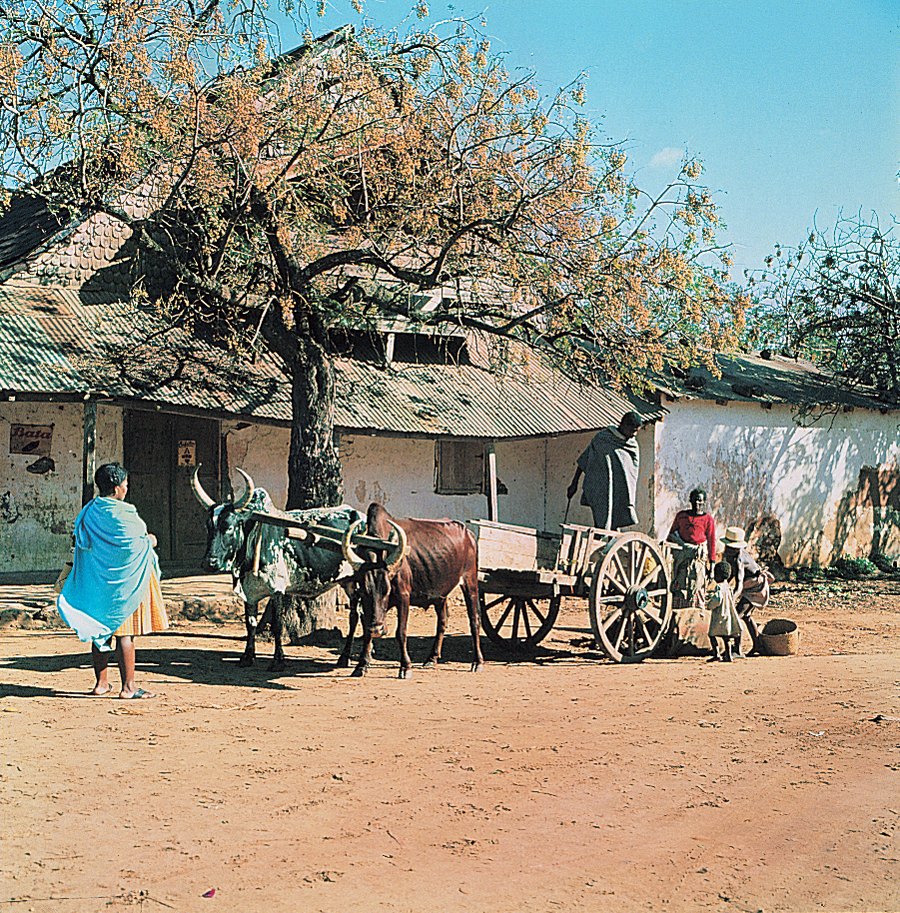
Central Madagascar consists of highlands with altitudes of 2,000 to 4,000 feet (610 to 1,200 meters) and some higher mountains. The region is deforested (cleared of trees) and the soil is eroded (worn away), but it has the densest population. In some places, farmers cut down the trees to make room for crops. Elsewhere, people turned forested land into pasture for their cattle, most of which are zebus. Zebus are a humped cattle native to India. Many people in Madagascar measure their wealth by the number of cattle they own. In fact, Madagascar has nearly as many zebus as it has people. But overgrazing by livestock has caused much of the country’s soil erosion. The highlands are cool, and temperatures at Antananarivo range between 48 and 81 °F (9 and 27 °C).
Animal and plant life.
Most kinds of animals and plants in Madagascar do not exist anywhere else in the world, except on the nearby Comoro Islands. The best-known wild animals in Madagascar are the lemurs. The country has about 20 species of these relatives of monkeys, most of which live in trees. Madagascar’s other animals include the tenrecs. Some of these small mammals resemble hedgehogs, and some resemble shrews. Other native animals include the Malagasy mongoose and local species of chameleons, tortoises, and moths and butterflies. The amazing elephant bird, which probably became extinct about 1,000 years ago, lived only in Madagascar. The bird, which could not fly, grew up to 10 feet (3 meters) tall and weighed about 1,000 pounds (450 kilograms). See Lemur; Tenrec; Elephant bird.
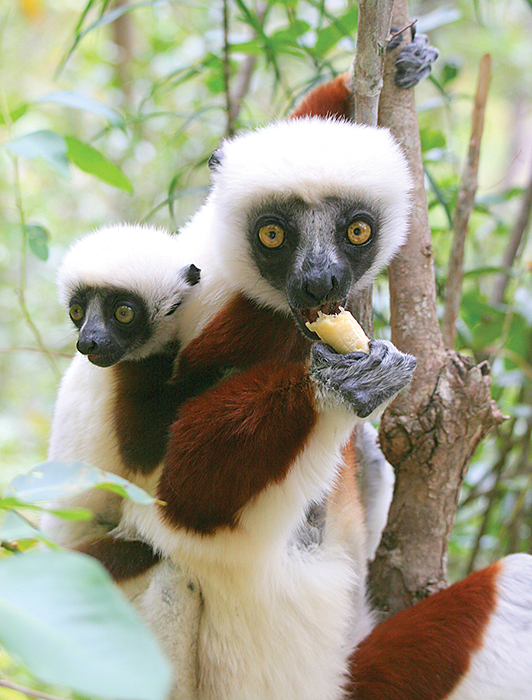
Madagascar’s forests, which formerly covered most of the island, now survive mostly near the coast. Nevertheless, many unique plants still grow on the island. About 1,000 orchid species live in the wet forests of the east. In the drier interior, grass has replaced most trees. But the region still has several varieties of baobab trees, which store water in their thick, bulging trunks. Wildlife preserves help protect some wild animals and plants.
Economy.
Madagascar is a poor country. About three-fourths of the people are farmers and herders. Rice is their chief food crop. Madagascar is one of the world’s leading producers of natural vanilla and cloves. Bananas, cassava, coffee, sugar cane, and sweet potatoes are also grown. Cattle, the country’s most important livestock, are raised for meat and milk.
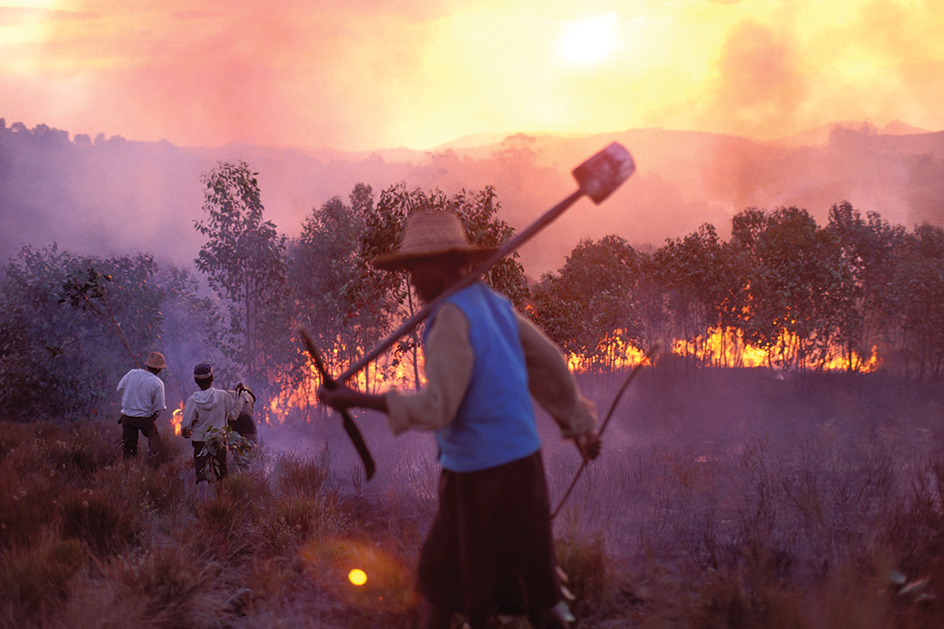
Madagascar manufactures cement, food and beverage products, paper, soap, and textiles. Madagascar’s government encourages foreign companies to build industrial plants in the country. Chromite, gemstones, graphite, and salt are mined in Madagascar.
Madagascar imports more than it exports. The country imports cars and trucks, food, machinery, and petroleum. The chief exports include clothing, fruits and vegetables, shrimp, and vanilla. Madagascar’s chief trading partners include China, France, and the United States.
Roads, most of which are unpaved, link the chief cities and towns of Madagascar. But many roads are impassable during the rainy season. Antananarivo has an international airport. Toamasina and Mahajanga are the leading seaports.
Several daily newspapers, representing a variety of political opinions, are published in Madagascar. The government operates the country’s main radio and television stations.
History.
Immigrants from Indonesia moved to the island in successive waves starting long before the time of Christ and lasting until the A.D. 1400’s. They settled in the central highlands. Immigrants from Africa and the Arabian Peninsula settled on the coasts. Many kingdoms developed, but in the early 1800’s the Merina kingdom gained control of most of the island.
Radama I, who became king in 1810, outlawed the buying and selling of enslaved people that had developed in Madagascar. However, he kept many local people in domestic enslavement. The king and his successors welcomed English and French traders and missionaries. The missionaries opened churches and schools, but Merina rulers allowed only the Merina people to attend the schools. In the 1840’s, Queen Ranavalona I tried to end European influence and expelled Europeans from the island. Europeans returned after she died in 1861. The French expanded their political influence in Madagascar after 1869. Conflicts broke out between the French and the Merina. The French forces gained control, and France made all of Madagascar a French colony in 1896.
During World War I (1914-1918), Merina leaders began to demand independence. In 1945, France gave the colony’s people some control of financial matters and the right to elect an assembly in 1945. It also allowed them to elect representatives to the French Parliament. But this did not satisfy the people. An armed revolt that lasted almost two years broke out in 1947.
In 1958, Madagascar became a self-governing state in the French Community, an organization that linked France and its overseas territories. Madagascar gained independence in 1960. French influence remained strong in the country, which was called the Malagasy Republic. Philibert Tsiranana was elected the country’s first president in 1959. He was reelected president in 1965 and 1972.
In May 1972, demonstrations caused Tsiranana to resign. Army officers then took control of the government. In 1975, Didier Ratsiraka became the fourth in a series of military rulers to head the government. Under Ratsiraka and the earlier military leaders, the government took control of important parts of the country’s economic activity, including many businesses owned by the French and other foreigners. In late 1975, the country changed its name from Malagasy Republic to Madagascar.
A presidential election was held in 1982, and the people elected Ratsiraka president. Since 1983, the government has lessened its role in Madagascar’s economy. Ratsiraka was reelected president in 1989. In 1991, a coalition of parties opposed to Ratsiraka called for his resignation. In 1991, Ratsiraka allowed Albert Zafy to take charge of a transitional government. In 1993, the people elected Zafy president. But in October 1996, Zafy resigned after he was impeached by the National Assembly on charges that he had engaged in unconstitutional acts. Ratsiraka was reelected president in a special election held in December 1996.
In December 2001, Ratsiraka faced Marc Ravalomanana, the mayor of Antananarivo, in a presidential election. According to official results, neither candidate received a majority of votes. Ravalomanana, however, claimed the election was rigged against him. His supporters staged mass protests and strikes in the capital. In February 2002, Ravalomanana declared himself president and formed a rival government, which took over government buildings in Antananarivo. Ratsiraka moved his government to the port city of Toamasina. His supporters set up roadblocks and blew up bridges to cut off the main supply routes to Antananarivo. Clashes between supporters of the two men became increasingly violent. In April, after a vote recount, the country’s High Constitutional Court declared that Ravalomanana had won the election. Ratsiraka rejected the court ruling.
In May, Ravalomanana was sworn into office. He kept control of the capital and gradually extended his control over the rest of the country. In July, Ratsiraka went into exile in France. In December 2006, Ravalomanana was reelected president.
As president, Ravalomanana welcomed foreign business investment in Madagascar, but opponents accused him of profiting personally while many of the country’s people remained in poverty. In early 2009, public resentment against the president, in part fueled by a proposed land deal with a foreign automaker, led to rioting. The mayor of Antananarivo, 34-year-old Andry Rajoelina, led calls for Ravalomanana to resign. The federal government removed Rajoelina from his mayoral post, and violence continued. A group of military officers loyal to Rajoelina seized the president’s office, and Ravalomanana stepped down. He turned over control of the country to the military, which installed Rajoelina as president.
International observers criticized the move as unconstitutional, in part because Madagascar’s constitution required people to be at least 40 years old before holding the office. The African Union suspended Madagascar from membership, calling the military’s action an illegal coup. In November, Ravalomanana, Rajoelina, and other political leaders agreed on a power-sharing deal that allowed Rajoelina to remain in office as president. However, Rajoelina quickly scrapped the deal and appointed an army colonel as prime minister. Ravalomanana fled to South Africa. In August 2010, a Malagasy court convicted him in absentia (while absent) of murder and sentenced him to life in prison. In a November referendum, voters approved a new constitution that lowered the presidential age requirement to 35. In December 2013, voters elected former Finance Minister Hery Rajaonarimampianina to the presidency. In January 2014, the African Union lifted Madagascar’s suspension.
In October, Ravalomanana returned to Madagascar and was placed under house arrest. President Rajaonarimampianina released Ravalomanana from custody in May 2015 as part of a national reconciliation effort.
In November and December 2018, Rajoelina defeated Ravalomanana after two rounds of presidential elections. Rajoelina took office as president in January 2019. He was reelected in 2023. The opposition boycotted the 2023 election, claiming it was not free or fair.
